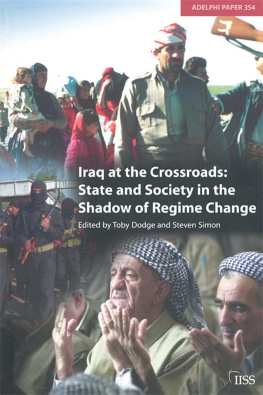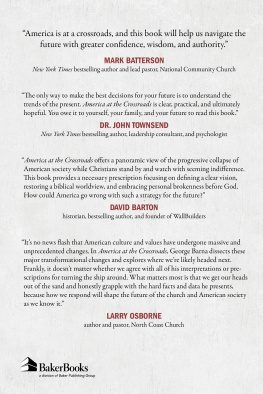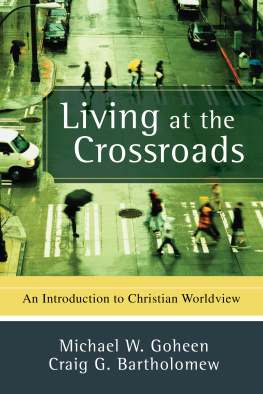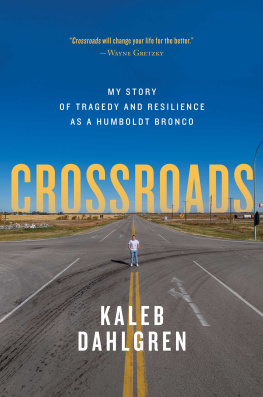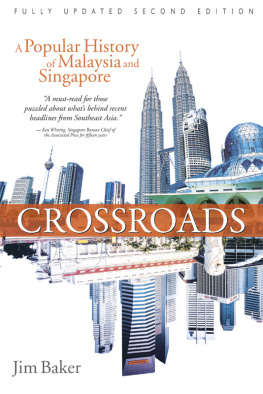Jim Baker - Crossroads
Here you can read online Jim Baker - Crossroads full text of the book (entire story) in english for free. Download pdf and epub, get meaning, cover and reviews about this ebook. publisher: Marshall Cavendish International, genre: Religion. Description of the work, (preface) as well as reviews are available. Best literature library LitArk.com created for fans of good reading and offers a wide selection of genres:
Romance novel
Science fiction
Adventure
Detective
Science
History
Home and family
Prose
Art
Politics
Computer
Non-fiction
Religion
Business
Children
Humor
Choose a favorite category and find really read worthwhile books. Enjoy immersion in the world of imagination, feel the emotions of the characters or learn something new for yourself, make an fascinating discovery.
Crossroads: summary, description and annotation
We offer to read an annotation, description, summary or preface (depends on what the author of the book "Crossroads" wrote himself). If you haven't found the necessary information about the book — write in the comments, we will try to find it.
Crossroads — read online for free the complete book (whole text) full work
Below is the text of the book, divided by pages. System saving the place of the last page read, allows you to conveniently read the book "Crossroads" online for free, without having to search again every time where you left off. Put a bookmark, and you can go to the page where you finished reading at any time.
Font size:
Interval:
Bookmark:

CROSSROADS
A Popular History of Malaysia and Singapore
FULLY UPDATED FOURTH EDITION
Jim Baker

2020 Marshall Cavendish International (Asia) Private Limited
First published in 1999
Fourth edition published in 2020 by Marshall Cavendish Editions
An imprint of Marshall Cavendish International

All rights reserved
No part of this publication may be reproduced, stored in a retrieval system or transmitted, in any form or by any means, electronic, mechanical, photocopying, recording or otherwise, without the prior permission of the copyright owner. Requests for permission should be addressed to the Publisher, Marshall Cavendish International (Asia) Private Limited, 1 New Industrial Road, Singapore 536196. Tel: (65)6213 9300. Email:
The publisher makes no representation or warranties with respect to the contents of this book, and specifically disclaims any implied warranties or merchantability or fitness for any particular purpose, and shall in no event be liable for any loss of profit or any other commercial damage, including but not limited to special, incidental, consequential, or other damages.
Other Marshall Cavendish Offices:
Marshall Cavendish Corporation, 99 White Plains Road, Tarrytown NY 10591-9001, USA Marshall Cavendish International (Thailand) Co Ltd, 253 Asoke, 12th Flr, Sukhumvit 21 Road, Klongtoey Nua, Wattana, Bangkok 10110, Thailand Marshall Cavendish (Malaysia) Sdn Bhd, Times Subang, Lot 46, Subang Hi-Tech Industrial Park, Batu Tiga, 40000 Shah Alam, Selangor Darul Ehsan, Malaysia.
Marshall Cavendish is a registered trademark of Times Publishing Limited
National Library Board, Singapore Cataloguing-in-Publication Data
Name(s): Baker, Jim (James Michael), 1948.
Title: Crossroads: A popular history of Malaysia and Singapore / Jim Baker.
Description: Fully updated fourth edition. | Singapore: Marshall Cavendish Editions, [2020]. | First published: 1999. | Includes bibliographical references and index.
Identifier(s): OCN 1127058722 | e-ISBN 978 981 4868 38 9
Subject(s): LCSH: SingaporeHistory. | MalaysiaHistory. | MalayaHistory. | SingaporePolitics and government. | MalaysiaPolitics and government.
Classification: DDC 959.5dc23
Printed in Singapore
TO THE FIRST EDITION
In the last quarter of the twentieth century, there has been much focus on what appears to be a shift in the worlds economic and political power from North America and Europe to Asia. This is underscored by the increasingly prominent roles played by Asia both economically and politically, which impact not only on the region but on the world at large. The change began with Japans tremendous economic growth after World War II and was followed by economic booms in Taiwan, South Korea, Singapore and Hong Kong. In the 1980s and 1990s, there was a third wave of growing economies in Malaysia, Indonesia and Thailand. The final act in this economic renaissance of Asia will be the rise of two of the potentially largest world economies India and China.
The economic downturn in the area in the late 1990s was no more than a temporary setback. Most economists believe Asia will emerge from the crisis to be just as important a player in the world economy as it was before the crisis.
There is a wealth of opinion and commentary about Asias growth and its ramifications. A running theme is that the underpinnings of Asias economic success are rooted in culture and values, that the rise of the East is driven by Asian values, which create the climate necessary for these societies to compete successfully with the West. Evidence of this view is contained in popular commentaries on the economic conflict between Japan and the United States in the 1970s and 1980s. It is seen in the stated attempts by many Asian leaders to protect their societies from the influences of popular Western culture lest they corrupt the foundations of their success. And this view has been further advanced by cultural critics in the West who warn of economic decline because of current social conditions in Western societies.
The problem is that to define Asian values is virtually impossible, and for politicians to portray economic competition in todays world as one between geographic areas is a gross oversimplification. To see Asia as a monolithic cultural entity defies imagination. Who really believes that an Uzbeki Afghan shares common values with a Japanese in Yokohama, that the Malay living in a village in Kelantan views the world the same way as a factory worker in Seoul, or that a Chinese peasant farmer could share a similar value system with a Dani tribesman in Irian Jaya? Perhaps a reason why Asians were deeply shocked by their economic crises in the late 1990s was the overemphasis by their leaders on the uniqueness of their success. These leaders had indicated that growth was a result of strong Asian values, which blurred true economic realities and offered a false sense of never-ending growth.
Malaysia and Singapore are fascinating cases of the strengths and weaknesses of this ongoing debate. The Malay Peninsula is an area where not only has the East met the West but also where the East has met the East a true crossroads.
This study of the history of Malaysia and Singapore offers a look at an area that contains cultural elements of many countries the indigenous influences of archipelago Southeast Asia; the impact of Asias cultural giants, China and India; the coming of Islam from western Asia by way of India; the contributions made by the West through European colonization and economic exploitation; and finally, the impact of the process of globalization on the two countries.
The history of Malaysia and Singapore is more than two thousand years of cultural interaction, largely determined by the geographic positions of these countries. In the last sixty years, it is a history of three distinct groups of Asians the Chinese, Indians and indigenous Malays all trying to find a common destiny. For in this sixty-year period, all three accepted the reality that they were going to live together permanently. The conflict, accommodation and promise of this reality are vital elements of life in the area today.
This book, then, has two themes. One is the movement of culture, products and people throughout the area, and the other is the people who stayed to create the modern nations. Economically, Malaysia and Singapore are rapidly developing, and perhaps by identifying the reasons for their success, these unique societies may give useful insight into some of the generalizations made about Asia today.
As political entities, Malaysia and Singapore are twentieth-century phenomena. As a result, looking at them historically must be in the context of the history of archipelago Southeast Asia. The two countries were part of a community of Malayan people and culture until the nineteenth century, and modern Singapores history in the nineteenth and early twentieth centuries was as part of a Malaya created by forces from outside the archipelago.
In the course of reading this book, there will be vocabulary and references to terms that may be unfamiliar to some readers. Most of these are defined in the context of their usage, but Malays, Malaya, Malayans, Malaysia and Malaysians are used frequently and do have different meanings. The Malays are a racial group, and Malay is their language. The Malays make up the majority of the population of the present-day Federation of Malaysia and a minority in the Republic of Singapore. Generally, the term includes a race of people who make up a significant portion of the population of southern Thailand and most of the populations of Indonesia and Brunei, as well as a minority in the southern Philippines. Collectively, they are the Malay people but only referred to in that way by the governments of Malaysia, Brunei, Singapore and Thailand.
Font size:
Interval:
Bookmark:
Similar books «Crossroads»
Look at similar books to Crossroads. We have selected literature similar in name and meaning in the hope of providing readers with more options to find new, interesting, not yet read works.
Discussion, reviews of the book Crossroads and just readers' own opinions. Leave your comments, write what you think about the work, its meaning or the main characters. Specify what exactly you liked and what you didn't like, and why you think so.




